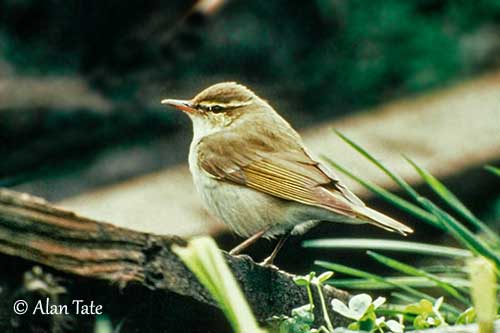
DESCRIPTION OF THE BIRD:
Biometrics:
Length: 13 cm
Weight: 9-13 g
The Kamchatka Leaf Warbler adult has olive-green head and upperparts, whereas throat and underparts are dull yellowish-white, generally duller than P. xanthodryas.
On the head, the conspicuous pale yellowish supercilium extends to the nape sides. We can see a dark eyestripe extending from lores to rear of ear-coverts where it becomes narrower.
The two-tone bill appears slightly heavier, with blackish upper mandible and yellow/pale orange lower mandible. The eyes are dark brown. Legs and feet are pale flesh.
Male and female are similar.
The juvenile resembles adult but it is duller overall, with greyer upperparts and more buffish underparts.
RANGE:
The Kamchatka Leaf Warbler breeds in NE Russia (Kamchatka), Sakhalin, Kuril Islands and N Japan (Hokkaido).
It winters from the Philippines, S to Bali and Lesser Sunda Islands.
HABITAT:
In Japan, in the Shiretoko Peninsula, the Kamchatka Leaf Warbler breeds in the birch-dwarf pine zone of the subalpine forest line. However, in Sakhalin and Kamchatka, it is found in deciduous forests (willows and birches) along rivers in lowlands.
On migration and during winter, it is generally below 1,800 metres of elevation in openings of mixed woodlands and at the edge of the rainforest. It also frequents secondary growths, edges of cultivated areas and plantations, and even gardens.
CALLS AND SONGS: SOUNDS BY XENO-CANTO
The Kamchatka Leaf Warbler’s call is a dry rattling “trrrt” or “trr-trrt” very similar to the call of the Arctic Warbler and both are difficult to separate. The call of the Kamchatka Leaf Warbler is usually lower, longer and harder.
The song is slightly harsh and fast, a short series of notes uttered in regular pulsating rhythm, resulting from the presence of two different types of syllables arranged in phrases given 3 to 8 times in succession.
There are numerous individual variations, but the syntax does not vary much. Each male may have up to 15 different strophe types. The song is sometimes a repeated single syllable added to the usual strophes. It is described as “treetreetreetreetreetreetreetree…”.
BEHAVIOUR IN THE WILD:
The Kamchatka Leaf Warbler feeds mainly on small insects and a variety of small invertebrates.
It forages actively, alone or in pairs, among the vegetation, in bushes and trees. It also hovers to reach and catch insects hidden under the foliage. Flying insects are caught in flight.
Outside of breeding season, they forage in mixed-species flocks in outer foliage and tree canopy.
The Kamchatka Leaf Warbler is said to be monogamous, but polygyny is occasionally recorded.
The male sings to defend the territory. The courtship displays are probably similar to that of the Arctic Warbler, with aggressive encounters between males and aerial chases. In pair formation, the male pursues the female in flight, and both mates perform slow wing-flapping with raised crown and rump feathers.
The Kamchatka Leaf Warbler is migratory and reaches the Philippines from September. The return migration occurs in March/June. They arrive on their breeding grounds from early June to mid-June.
The species is recorded in the Aleutian Islands (W Alaska).
The flight is weak and fluttering, with rapid, shallow wingbeats.
REPRODUCTION OF THIS SPECIES:
The breeding season takes place from June to August.
The Kamchatka Leaf Warbler usually produces a single brood, occasionally two.
The nest is dome-shaped with a lateral entrance. It is built on the ground, well-hidden among the vegetation or tree roots, and other concealed sites.
The nest is made of grass stalks, reeds, moss, vegetal fibres and shoots, and the cup is lined with softer material.
The female lays 5-6 eggs and incubates alone during 13-14 days. Both parents feed the chicks. The young fledge 13-14 days after hatching.
PROTECTION / THREATS / STATUS:
The Kamchatka Leaf Warbler is described as locally common.
The size of the population is unknown since the species was split, but it is suspected to be stable.
However, the species could be affected in the future by habitat loss.
But currently, the Kamchatka Leaf Warbler is not globally threatened and currently evaluated as Least Concern.
Fr: Pouillot du Kamtchatka
Ang: Kamchatka Leaf Warbler
All: Wanderlaubsänger
Esp: Mosquitero de Kamchatka
Nd: Kamtsjatkaboszanger
Sd: kamtjatkanordsångare
Photographers:
Alan & Ann Tate
AA Bird Photography
Text by Nicole Bouglouan
Sources:
HANDBOOK OF THE BIRDS OF THE WORLD Vol 11 by Josep del Hoyo, Andrew Elliott and David Christie - Lynx Edicions - ISBN: 849655306X
A Field Guide to the Birds of South-East Asia by Craig Robson. New Holland Publishers. ISBN: 9781780090498
The Arctic Warbler Phylloscopus borealis – three anciently separated cryptic species revealed
“Arctic Warblers” – three species instead of one
Ask The Experts: The Arctic Warbler Splits
Fatbirder - Phylloscopidae – Leaf Warblers & Allies
Wikipedia, the free encyclopaedia
Kamchatcka Leaf Warbler
Phylloscopus examinandus
Passeriformes Order – Phylloscopidae Family
INTRODUCTION:
The Kamchatka Leaf Warbler was formerly included in the “Old World Warblers” assemblage. It was previously considered a synonym of “Phylloscopus xanthodryas” which was treated as a subspecies of the Arctic Warbler - Phylloscopus borealis, but it differs in some morphological features, habitat and song.
The Kamchatka Leaf Warbler breeds in Kamchatka, Sakhalin and the Kuril Islands, and moves southwards to spend the winter in Indonesia and the Philippines.
It frequents deciduous forests when breeding, and prefers openings of mixed woodlands and forest edges both on migration and during winter. It feeds mainly on insects and small invertebrates. The globular nest is built on the ground, hidden in the vegetation or in tree roots.
The Kamchatka Leaf Warbler is described as locally common with stable population, and currently, the species is not globally threatened.
